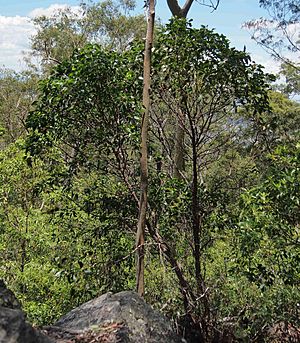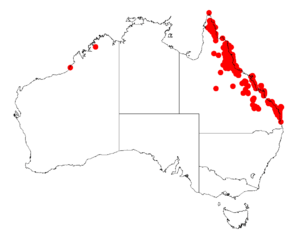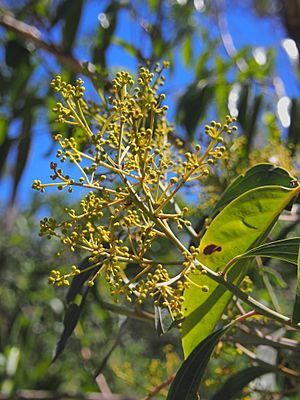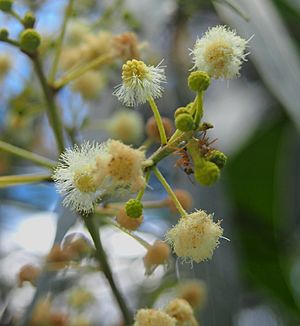Yellow wattle facts for kids
Quick facts for kids Yellow wattle |
|
|---|---|
 |
|
| Scientific classification | |
| Genus: |
Acacia
|
| Species: |
flavescens
|
 |
|
| Occurrence data from AVH | |
The Acacia flavescens, also known as the red wattle, yellow wattle, or primrose ball wattle, is a type of tree. It belongs to the Acacia family and grows naturally in eastern Australia.
Contents
What Does the Yellow Wattle Look Like?
This tree usually grows to be about 6 to 20 metres (20 to 66 ft) tall. Its bark is rough, has deep grooves, and looks shaggy. It is usually brown. The tree's branches are a bit angular and have a yellowish color, which helps explain its common name.
Leaves and Flowers
The leaves of the Yellow Wattle stay green all year round. They are shaped like long, narrow ovals or spears. These leaf-like structures, called phyllodes, are usually 9 to 30 centimetres (4 to 12 in) long and 2 to 6 cm (0.8 to 2.4 in) wide.
When the tree blooms, it produces round flower heads. These flower heads are about 4.5 to 6 mm (0.18 to 0.24 in) across and contain 30 to 60 cream-colored flowers.
Seed Pods
After the flowers bloom, the tree forms flat, smooth seed pods. These pods can be up to 12 cm (5 in) long and 1.5 to 2.5 cm (0.6 to 1.0 in) wide. Inside the pods are dull black seeds. Each seed is shaped like an oval and is about 6 to 7 mm (0.24 to 0.28 in) long.
How the Yellow Wattle Got Its Name
The first time a sample of this tree was collected was in 1819. This happened along the coast of Queensland, Australia. The botanist Allan Cunningham collected it while on a ship called HMS Mermaid.
The tree was officially described in 1842 by George Bentham. He included it in a book called Notes on Mimoseae, with a synopsis of species. Later, in 1987, it was given a different scientific name, Racosperma flavescens. However, in 2006, it was moved back to the Acacia family. The Yellow Wattle is closely related to another tree called Acacia leptoloba.
Where the Yellow Wattle Grows
You can find the Yellow Wattle across much of eastern Queensland, Australia. It mostly grows in areas near the coast. Its range stretches from Cape York in the north down to Brisbane in the south.
This tree is often found in Eucalypt forests and woodlands. It prefers sandy soils and also grows along the edges of monsoon forests and rainforests. It can grow from sea level up to about 1,000 metres (3,281 ft) high.
Growing and Using the Yellow Wattle
The Yellow Wattle is sold as young plants or as seeds. Before planting, the seeds need a special treatment. You can either scratch their outer layer (scarifying) or soak them in hot water.
This tree grows well in sunny spots and can thrive in many different types of soil, even poor ones. It grows quickly and can even sprout new shoots from its roots. This means it can sometimes spread easily.
Helping the Soil
The Yellow Wattle has a special relationship with tiny living things called nitrogen fixing bacteria. These bacteria live on the tree's roots and help add important nutrients to the soil. This makes the soil healthier.
Other Uses
The wood from the Yellow Wattle can be used as fuel. The tree is also planted to help keep soil in place and prevent erosion. Its bark contains a substance called tannin, which can be used for various purposes.
Historically, the bark has been used in traditional medicine. It has properties that can help heal wounds when applied externally. It was also used internally to help with stomach issues like diarrhoea and dysentery.



